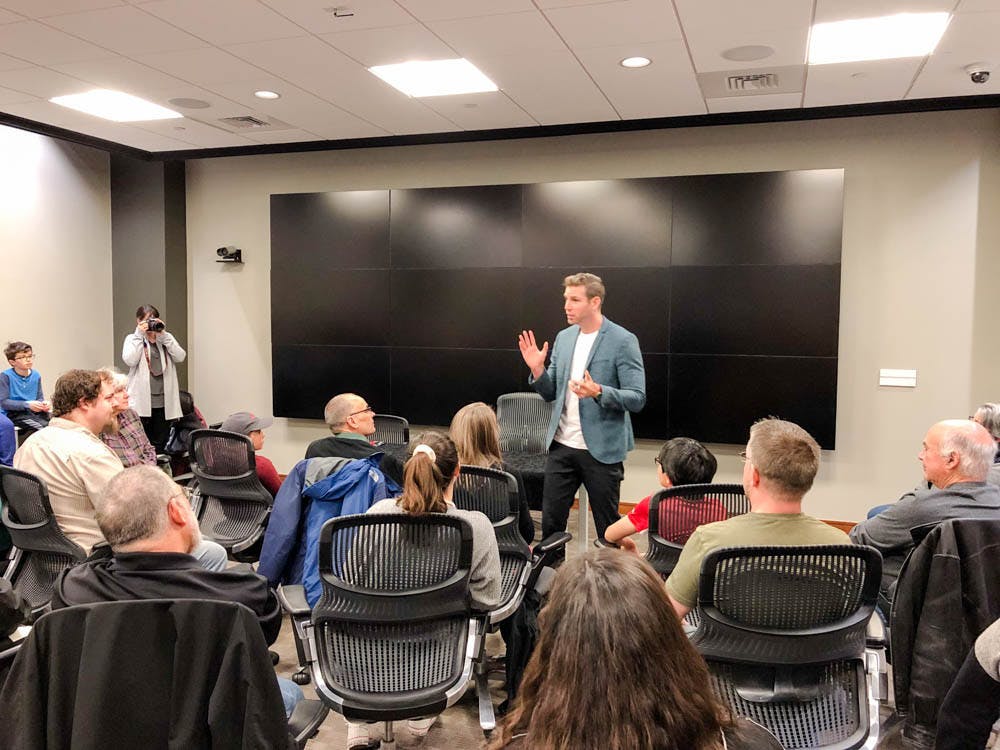Blindfolded and with his back turned away, the magician instructed a volunteer to think of a card and communicate its number and suit to the rest of the audience silently. Without speaking or showing their chosen card — the seven of diamonds — the volunteer dealt seven cards to represent its value and four cards to represent the diamond suit.
Still blindfolded, the magician sifted through the face-down cards, using only his sense of touch to “feel” for the volunteer’s chosen card. Raising a single card in the air, he asked, “Is this by chance a seven of diamonds?” The surprised audience erupted in applause.
This magic trick was one of three that the magician and bestselling author Joshua Jay performed during “Office Hours with a Magician” Tuesday afternoon. Jay, who fooled magician duo Penn & Teller on their show “Fool Us” with this card trick, is a former world champion of magic who has performed in 110 countries and has helped design illusions for the HBO show “Game of Thrones.” Alongside the close-up magic, Jay also answered audience questions about the craft of magic and his own experience as a magician. The event was followed by a talk called “Tragic Magic,” Jay’s evening lecture on the magicians, spectators and assistants who died in the act of magic.
During “Office Hours,” Jay told the audience his interest in magic began when he was six years old after his father performed a card trick for him and didn’t tell him how it worked. Frustrated, the young Jay went into his room, where he “made charts and tore up three decks of cards.” After about three hours, he went back downstairs and showed the same trick to his father.
“Everything in that little story is everything I still love about magic,” Jay said. “I still love to be amazed by everything. I still like to get inspiration from outside magic or my trade. But then figuring it out, figuring out a way to do it, that’s how I spend 75 percent of my career — in my boxer shorts, on the floor of my apartment, making charts and figuring out magic.”
Jay also discussed the psychology that fuels spectators’ interest in magic, the techniques of renowned magician David Blaine and the physical and mental distractions that magicians use to fool their audience.
Jay’s process for magic consists of two parts — a dreaming part and a “toolbox” part. The dreaming part begins, for example, with “a pie in the sky” visualization of the trick’s surprise. From this initial conceptualization of a trick, Jay then turns to what he calls his “toolbox,” which is filled with the knowledge he has gained from years of reading books, magazines and attending lectures. “You get this toolbox to try to patch together a method, and the scary part is that you have to try it out and hope that it doesn’t fail completely,” Jay said.
The dangerous side to magic was brought up by Logan Cody ’19, one of the attendees at Jay’s “Office Hours.” Cody asked Jay if he felt there was “a point of diminishing returns with how dangerous an illusion can be” as spectators can either be impressed with the trick or attribute it to a set of fake props. In response, Jay said that magicians in the past and present are able to cleanly establish a trick as real and that spectators “attach to that reality.”
Having not seen any of Jay’s performances prior to the event, Cody came to the event doubtful of the authenticity of magic. “As a layperson, as a skeptic, no matter how real anything seems, there’s always a part of me that goes, ‘Oh, well that’s fake,’” Cody said. After watching Jay perform, Cody added that he was “more appreciative” of the work of magicians and that “part of the fun is trying to guess on what’s happening.”
For the evening event, Jay emotionally told the stories of fallen magicians such as Balabrega and Chung Ling Soo, who died while performing magic.
Jay began his lecture with the story of Sigmund Neuberger, who went by the stage name the Great Lafayette. Lafayette was in the process of performing a trick when the theater caught fire from the oil lamps used for his act. Authorities found what they thought to be his burnt body, but days later, the actual body of Lafayette was found. The previously discovered body had been his body double — Lafayette had escaped but went back into the burning theater for his beloved horse and soon perished. As a result, Lafayette had not one, but two funerals.
This story was interesting to Janet Qi ’22, who added that she liked how Jay “combined PowerPoint slides and music” into his presentation because it added “a historical lens.” As a fan of Penn & Teller’s show, Qi said she decided to attend the event because Jay had been a guest on the show.
Jay concluded the evening show with one of “Houdini’s most dangerous but most beautiful illusions.” Jay swallowed several sewing needles, having audience members check his mouth and touch his throat to confirm.
“It’s always the magician’s job to blur the line between reality and illusion,” Jay said. “What you just saw is very real, but this is the illusion.” Jay then proceeded to place a string into his mouth, grunting momentarily before pulling the string out, this time with the swallowed needles hanging off from it.





